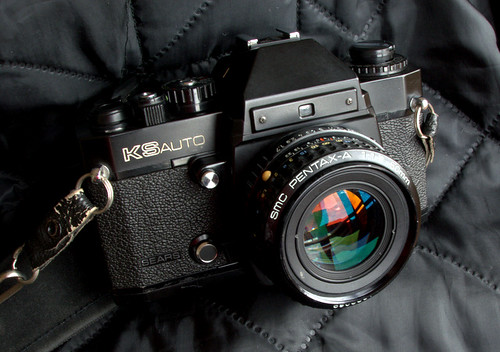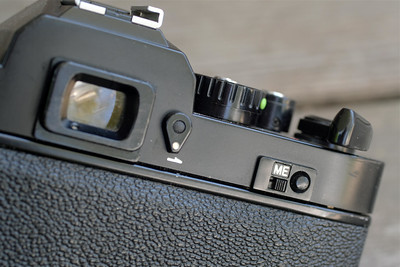Difference between revisions of "Sears KS Auto"
m (clearer phrasing/formatting) |
Hanskerensky (talk | contribs) (Added Category:K|KS Auto Sears]) |
||
| (6 intermediate revisions by one other user not shown) | |||
| Line 1: | Line 1: | ||
| − | |||
{{Flickr_image | {{Flickr_image | ||
|image_source= https://www.flickr.com/photos/98922823@N00/15126490931/in/pool-camerawiki | |image_source= https://www.flickr.com/photos/98922823@N00/15126490931/in/pool-camerawiki | ||
| Line 9: | Line 8: | ||
}} | }} | ||
| − | The '''KS Auto''' was introduced by US retailer [[Sears]] in 1979, joining the [[Sears KS 500 |KS 500]] and [[Sears KS 1000 | KS 1000]]<ref>See them on [https://christmas.musetechnical.com/ShowCatalogPage/1979-Sears-Fall-Winter-Catalog/1268 page 1268 of the scanned Fall/winter 1979 catalog] from [https://christmas.musetechnical.com/ Musetechnical's "Christmas Catalogs & Holiday Wishbooks."]</ref> to become their top-end offering. For this | + | The '''KS Auto''' was introduced by US retailer [[Sears]] in 1979, joining the [[Sears KS 500 |KS 500]] and [[Sears KS 1000 | KS 1000]]<ref>See them on [https://christmas.musetechnical.com/ShowCatalogPage/1979-Sears-Fall-Winter-Catalog/1268 page 1268 of the scanned Fall/winter 1979 catalog] from [https://christmas.musetechnical.com/ Musetechnical's "Christmas Catalogs & Holiday Wishbooks."]</ref> to become their top-end offering. For this brief moment, the naming scheme of Sears [[SLR]]s was a model of clarity: "'''K'''" for [[K mount lenses | K-mount]] interchangeable lenses; "'''S'''" for Sears, and '''500''', '''1000''', or '''Auto''' to indicate the shutter variant which differentiates the three options.<ref>Fans of Sears cameras should pause and savor this moment, because after 1980's [[Sears KSX | "KSX,"]] their SLR naming scheme becomes a puzzling jumble of KS's, KSX's and "Supers"; just as the designations of the source [[Ricoh#SLR.2C_focal_plane | Ricoh]] models also confusingly metastasized.</ref> As with the other Sears SLRs this is a rebadging of a [[Ricoh]] model, the [[Ricoh XR-2 | XR-2s]] introduced a few months earlier. |
| − | The | + | The camera weighs 560g and has fairly unremarkable dimensions among other 1970s SLRs,<ref>However by 1979, competitors like the [[Olympus_OM-1/2/3/4#OM-2 | Olympus OM-2]] and [[Pentax ME]] had already shown the way towards much smaller and lighter autoexposure SLRs.</ref> but feels solid, with styling that strikes one as particularly boxy and businesslike. |
| − | + | The KS Auto is quite a full-featured camera, surprisingly so for a general-merchandise retailer like Sears. It offers aperture-priority autoexposure via an electronically-timed vertically-traveling shutter over a range from 1/1000 to 8 seconds. It has depth-of-field preview, a locking ASA dial, a built-in eyepiece blind, a self-timer, and an M.E. button on the rear for [[multiple exposure]]s. There is a mechanical 1/90th second X-[[flash sync|sync]] speed, although two 1.5v batteries are necessary for other auto and manual shutter settings. | |
| + | |||
| + | Both shutter speed and aperture are displayed alongside the viewfinder image, the latter using the peepsight on the front of the [[pentaprism]] for a direct view of the aperture ring setting. The shutter and meter only operate after the advance lever is pulled outwards to expose a red dot. The ASA scale also lifts and turns to provide 2 stops +/- of exposure biasing; but there is no reminder of this in the viewfinder. | ||
| + | |||
| + | As clever as the aperture window was, in practice it is tricky to align one's eye in exactly the position to make it useful;<ref>The [[Pentax MX]] is an SLR using a similar system, but implemented much more successfully; its direct view window appears taller and with higher magnification.</ref> and this is one of the features dropped on subsequent Sears/Ricoh SLRs. The price of a full outfit with an f/1.4 normal lens, telephoto, flash, and gadget bag was a steep USD $399,<ref>[https://christmas.musetechnical.com/ShowCatalogPage/1980-Sears-Spring-Summer-Catalog/1167 Page 1167 of the scanned Spring/Summer 1980 catalog] from [https://christmas.musetechnical.com/ Musetechnical's "Christmas Catalogs & Holiday Wishbooks."]</ref> almost $1,300 in 2021 dollars, and cheaper alternatives like the [[Sears KSX | KSX]] were emphasized in later Sears offerings. | ||
| + | |||
| + | The [[Sears KS-1 & KS-2 | KS-2]] was Sears' most direct successor model to the KS Auto, albeit with a slightly less convenient manual-exposure mode. | ||
==Notes== | ==Notes== | ||
| Line 21: | Line 26: | ||
*Original [http://www.butkus.org/chinon/ricoh/xr-2s/xr-2s-splash.htm Ricoh XR-2s manual] from Mike Butkus' [http://www.butkus.org/chinon/ OrphanCameras.com] | *Original [http://www.butkus.org/chinon/ricoh/xr-2s/xr-2s-splash.htm Ricoh XR-2s manual] from Mike Butkus' [http://www.butkus.org/chinon/ OrphanCameras.com] | ||
*[https://www.flickr.com/photos/vox/51165128514/in/pool-camerawiki/ The KS Auto and its siblings and accessories] shown in the Spring/Summer 1980 "Midwest" Sears catalog, scan courtesy [https://www.flickr.com/photos/vox/ Voxphoto] | *[https://www.flickr.com/photos/vox/51165128514/in/pool-camerawiki/ The KS Auto and its siblings and accessories] shown in the Spring/Summer 1980 "Midwest" Sears catalog, scan courtesy [https://www.flickr.com/photos/vox/ Voxphoto] | ||
| + | {{br}} | ||
| + | {|class=floatleft | ||
| + | | | ||
| + | {{Flickr_image | ||
| + | |image_source= https://www.flickr.com/photos/vox/51180740263/in/pool-camerawiki/ | ||
| + | |image= https://live.staticflickr.com/65535/51180740263_eb48845bc3_w.jpg | ||
| + | |image_align= left | ||
| + | |image_text= Self timer and depth-of-field preview | ||
| + | |image_by= | ||
| + | |image_rights= | ||
| + | }} | ||
| + | | | ||
| + | {{Flickr_image | ||
| + | |image_source= https://www.flickr.com/photos/vox/51179833957/in/pool-camerawiki/ | ||
| + | |image= https://live.staticflickr.com/65535/51179833957_55ed099e90_w.jpg | ||
| + | |image_align= left | ||
| + | |image_text= Eyepiece shutter and multi-exposure controls | ||
| + | |image_by= | ||
| + | |image_rights= | ||
| + | }} | ||
| + | |- | ||
| + | |colspan=2 align=center | Details of the '''Sears KS Auto'''<br/><small>images by {{image author|Voxphoto}}</small> {{non-commercial}} | ||
| + | |} | ||
| + | |||
| + | [[Category:Sears]] | ||
| + | [[Category:K mount]] | ||
| + | [[Category:Japanese 35mm SLR]] | ||
| + | [[Category:K|KS Auto Sears]] | ||
Latest revision as of 18:07, 31 May 2021

|
| A full-featured K-mount camera from Sears this example missing its self-timer lever image by Paulo Moreira (Image rights) |
The KS Auto was introduced by US retailer Sears in 1979, joining the KS 500 and KS 1000[1] to become their top-end offering. For this brief moment, the naming scheme of Sears SLRs was a model of clarity: "K" for K-mount interchangeable lenses; "S" for Sears, and 500, 1000, or Auto to indicate the shutter variant which differentiates the three options.[2] As with the other Sears SLRs this is a rebadging of a Ricoh model, the XR-2s introduced a few months earlier.
The camera weighs 560g and has fairly unremarkable dimensions among other 1970s SLRs,[3] but feels solid, with styling that strikes one as particularly boxy and businesslike.
The KS Auto is quite a full-featured camera, surprisingly so for a general-merchandise retailer like Sears. It offers aperture-priority autoexposure via an electronically-timed vertically-traveling shutter over a range from 1/1000 to 8 seconds. It has depth-of-field preview, a locking ASA dial, a built-in eyepiece blind, a self-timer, and an M.E. button on the rear for multiple exposures. There is a mechanical 1/90th second X-sync speed, although two 1.5v batteries are necessary for other auto and manual shutter settings.
Both shutter speed and aperture are displayed alongside the viewfinder image, the latter using the peepsight on the front of the pentaprism for a direct view of the aperture ring setting. The shutter and meter only operate after the advance lever is pulled outwards to expose a red dot. The ASA scale also lifts and turns to provide 2 stops +/- of exposure biasing; but there is no reminder of this in the viewfinder.
As clever as the aperture window was, in practice it is tricky to align one's eye in exactly the position to make it useful;[4] and this is one of the features dropped on subsequent Sears/Ricoh SLRs. The price of a full outfit with an f/1.4 normal lens, telephoto, flash, and gadget bag was a steep USD $399,[5] almost $1,300 in 2021 dollars, and cheaper alternatives like the KSX were emphasized in later Sears offerings.
The KS-2 was Sears' most direct successor model to the KS Auto, albeit with a slightly less convenient manual-exposure mode.
Notes
- ↑ See them on page 1268 of the scanned Fall/winter 1979 catalog from Musetechnical's "Christmas Catalogs & Holiday Wishbooks."
- ↑ Fans of Sears cameras should pause and savor this moment, because after 1980's "KSX," their SLR naming scheme becomes a puzzling jumble of KS's, KSX's and "Supers"; just as the designations of the source Ricoh models also confusingly metastasized.
- ↑ However by 1979, competitors like the Olympus OM-2 and Pentax ME had already shown the way towards much smaller and lighter autoexposure SLRs.
- ↑ The Pentax MX is an SLR using a similar system, but implemented much more successfully; its direct view window appears taller and with higher magnification.
- ↑ Page 1167 of the scanned Spring/Summer 1980 catalog from Musetechnical's "Christmas Catalogs & Holiday Wishbooks."
Links
- Original Ricoh XR-2s manual from Mike Butkus' OrphanCameras.com
- The KS Auto and its siblings and accessories shown in the Spring/Summer 1980 "Midwest" Sears catalog, scan courtesy Voxphoto
|
| ||||
| Details of the Sears KS Auto images by Voxphoto (Image rights) | |||||

